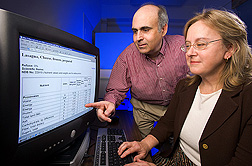|
Read the
magazine
story to find out more. |
|

Nutritionists David
Haytowitz and Pamela Pehrsson use the Nutrient Data Laboratory’s online
search program to locate the nutrient content of a food item. The online
resource is updated with information based on the National Food and Nutrient
Analysis Program. Click the image for more information about
it.
|
|

|
Nutritional "Report Cards" Rely on USDA
Data
By Rosalie
Marion Bliss August 24, 2007
Across the country each day, dietitians interview clients one-on-one
and record every food and beverage the client consumed over a given time
period. With the push of a button, these dietitians are able to provide their
clients with a nutritional "report card" and also to plan healthful dietary
adjustments. Commercially available software programs that provide such
custom-made printouts are driven by data developed by the Agricultural Research
Service's (ARS) Nutrient Data Laboratory
(NDL),
Beltsville, Md.
The NDL is one of six laboratories at the
ARS
Beltsville Human Nutrition Research Center. ARS is the
U.S. Department of Agriculture's chief
scientific research agency.
So how do dietitians calculate the amounts of nutrients people get,
based on a list of foods and drinks they report as having consumed? NDL
researchers develop specialized databases--available free to consumers and
professionals--that provide quality data on the content of calories, protein,
fat, carbohydrates, vitamins and minerals in both single- and multi-ingredient
foods. When these data are subsequently uploaded into any of a variety of
software packages, the programs are able to estimate the amounts of a wide
variety of nutrients consumed.
At the heart of projects to determine a suite of calories and
nutrients in U.S. foods is the
National Food and
Nutrient Analysis Program. This year marks the 10th anniversary of a
partnership in which NDL researchers work with other research groups within the
Bethesda, Md.-based National Institutes of
Health. Through these collaborations, food-nutrient data are generated and
updated on a regular basis.
Nutrient data derived by NDL researchers also serve as the basis for
USDA's MyPyramid Tracker, a
highly interactive, free Internet service that provides a customized
nutritional "audit" to individuals who report the foods and beverages they've
consumed on a given day. The data are also used for a variety of studies,
assessments and surveys, according to nutritionists
David
Haytowitz and
Pamela
Pehrsson, who oversee the analysis program at the Nutrient Data Laboratory.
Read more
in the August issue of Agricultural Research magazine.